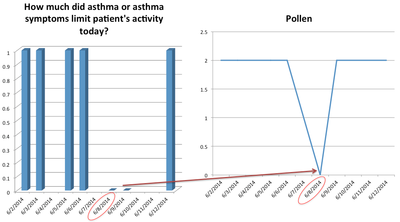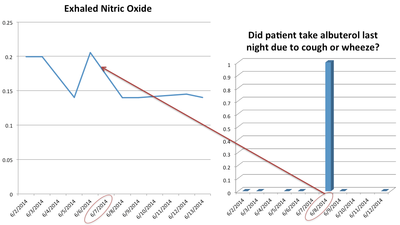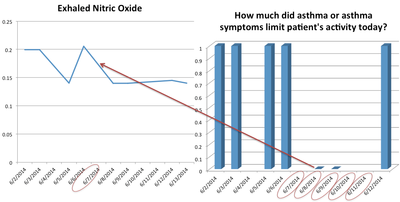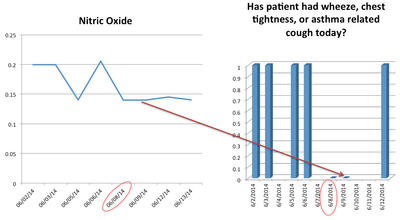Dementia
Contents
Motivation and Background
Alzheimer’s disease affects more than 5 million people claiming over 500,000 Americans annually [1]. As the sixth leading cause of death in Americans [1], its management is challenging. Current reactive healthcare costs more than 17% of GDP in the US [3, 4]. Alzheimer’s related healthcare costs alone are around $150 billion a year to Medicare and Medicaid [1]. To add to the challenge, dementia is an umbrella term that encompasses various forms of the disease such as Alzheimer’s disease, vascular dementia, and Huntington’s disease, to name a few [2]. Not only are the healthcare costs associated with dementia staggering, but the impact on the caregivers is also a critical challenge; in 2013, 15.5 million family and friends provided 17.7 billion hours of unpaid care to those with Alzheimer's and other forms of dementia – care valued at $220.2 billion [1]. With the exponential rise of the older population due to the baby boomers, the number of people with Alzheimer’s disease (the most prevalent form of dementia) is estimated to reach around 13.8 million [1,6]. This creates the strong need for unobtrusive sensing modalities that can help monitor people with dementia and support caregivers.
Dementia: Challenges and Opportunities
Asthma is a good example of a problem that spans Physical-Cyber-Social (PCS) systems. The health signals related to asthma spans Physical (environmental), Cyber (CDC reports), and Social (asthma/symptom reports on social media) modalities. Specifically, for asthma, we group health signals as personal (wheezing level, exhaled Nitric Oxide), population (asthma reports on social media), and public health signals (CDC asthma reports).
kHealth for Dementia
We tackle this important problem by a combination of active and passive sensing. Active sensing involves the patient in the loop (obtrusive) while the passive sensing does not involve patient involvement (unobtrusive). Using a novel approach of utilizes low-cost sensors for continuous monitoring (active and passive sensing), we propose to develop algorithms that can take this multi-modal data and translate them to practical and actionable information for asthma patients and their healthcare provider. Specifically, provide information on asthma control level based on symptoms and their severity, asthma triggers and early alerts for increasing asthma symptoms.
kHealth Observations
Asthma is a multi-faceted problem and we propose a holistic solution for
Personal
Physiological: Wheezometer [6], Nitric Oxide [7], Accelerometer, Microphone, Contextual Questions
Environmental: Sensordrone [8], Dust Sensor [9], Location
Public Health
CDC [10], DCHC’s EMR Records (periodic manual review)
Population Level
Everyaware [11], AirQuality Egg [12], Allergy Alerts [13,14], Social Observations (e.g., tweets), Air Quality Index[15]
Preliminary Data Analysis
kHealth kit could be used to collect observations (both sensor and patients questionnaire response) in the patient home environment (which was never accessible in a quantitative form to doctors). These observations when collected based on expert guidance, prove valuable for clinical decision support. These observations when interpreted by a doctor, lead to some interesting insights:
- Medication (Albuterol) use possibly leading to decreasing exhaled Nitric Oxide
- Activity limitation is likely related to high exhaled Nitric Oxide
- Low exhaled Nitric Oxide observed with absence of coughing
- Activity limitation observed with high pollen activity

THESE PRELIMINARY FINDINGS NEED TO BE VALIDATED IN LARGER STUDIES
Dataset Size
We collect observations from three sensors (temperature, humidity, Carbon monoxide) on Sensordrone at the rate of 1 Hz (1 observation / second). Nitric Oxide observations from the NODE sensor are collected at the rate of 2 observations / day. Patients answer a questionnaire which has 5 questions resulting in 5 observations / day. For a single patient, we collect over 250,000 observations / day. In our study of three patients, we have collected over 9 million data points.
IRB
Dayton Children's Hospital Institutional Review Board (IRB) approved the pilot study in October 2013 which began enrolling pediatric patients and their parents to use the kHealth kit for Asthma. IRB continuation was approved in October 2014. Please contact Prof. Amit Sheth [amit at knoesis.org] or Dr. Shalini Forbis [ForbisS at childrensdayton.org] to obtain the exact copy of IRB.
kHealth User Manual
kHealth Video Introduction
Related Talks and Presentations
References
[1] Alzheimer’s Association description of Alzheimer’s statistics, Available online at: http://www.alz.org/alzheimers_disease_facts_and_figures.asp #quickFacts
[2] Dementia related facts, Available online at: http://www.cdc.gov/mentalhealth/basics/mental- illness/dementia.htm
[3] D. A. Squires, “The U.S. Health System in Perspective: A Comparison of Twelve Industrialized Nations,” June 2011, Available online at: http://bit.ly/oZwhFZ
[4] Health Costs: How the U.S. Compares With Other Countries, Available online at: http://www.pbs.org/newshour/rundown/2012/10/health-costs-how-the-us-compares-with-other-countries.html
[5] Quantified Self http://quantifiedself.com/ [6] G. K. Vincent, V. A. Velkof, “The next four decades: The older population in the United States: 2010 to 2050.” Washington, D.C.: U.S. Census Bureau; 2010.
[7] Hexoskin. www.hexoskin.com
[8] A. Pasolini, "Sensor-packed Hexoskin shirt measures performance in real time". Available at: http://www.gizmag.com/hexoskin-sensor-t-shirt-body-metrics/29098/ Gizmag. September 19, 2013.
[9] kHealth: A knowledge-enabled semantic platform to enhance decision making and improve health, fitness, and well-being, Available online at: http://knoesis.org/projects/khealth (Accessed May 27, 2013).
[10] V. Santhisagar, T. Ioannis, B. Diane, J. C. Faquir, P. Fotios, "Emerging synergy between nanotechnology and implantable biosensors: A review." Biosensors and Bioelectronics 25.7: 1553-1565, 2010.
[11] J. S. Karlsson, U. Wiklund, L. Berglin, N. Östlund, M. Karlsson, T. Bäcklund, & L. Sandsjö, “Wireless monitoring of heart rate and electromyographic signals using a smart T-shirt.” In Proceedings of International Workshop on Wearable Micro and Nanosystems for Personalised Health, 2008.
[12] M. Chan, E. Campo, D. Estève, & J. Y. Fourniols, "Smart homes—current features and future perspectives. " Maturitas, 64(2), 90-97, 2009.
[13] E. Topol, “The creative destruction of medicine: How the digital revolution will create better health care.” Basic Books (AZ), 2012.
[14] T. Banerjee, M. Skubic, J. M. Keller & C. C. Abbott, "Sit-To-Stand Measurement For In Home Monitoring Using Voxel Analysis," IEEE Journal of Biomedical and Health Informatics, 18(4):1502-1509, 2014.
[15] T. Banerjee, M. Rantz, M. Li, M. Popescu, E. Stone & M. Skubic, "Monitoring Hospital Rooms for Safety Using Depth Images," Proceedings, AAAI Fall Symposium Series - AI for Gerontechnology, Washington DC, November 2-4, 2012.
[16] M. Gietzelt, K. H. Wolf, M. Kohlmann, M. Marschollek, and R. Haux. "Measurement of Accelerometry-based Gait Parameters in People with and without Dementia in the Field." Methods Inf. Med 52, no. 4: 319-325, 2013.
[17] E. Stone & M. Skubic, "Evaluation of an Inexpensive Depth Camera for In-Home Gait Assessment," Journal of Ambient Intelligence and Smart Environments, 3(4):349-361, 2011.
[18] A. L. Bleda, R. Maestre, A. J. Jara, & A. G. Skarmeta, “Ambient Assisted Living Tools for a Sustanaible Aging Society.” In Resource Management in Mobile Computing Environments pp. 193-220. Springer International Publishing, 2014.
[19] J. L. Cummings, “The Neuropsychiatric Inventory: Assessing psychopathology in dementia patients.” Neurology 48 (Supple 6): S10-S16,1997.
[20] W. E. Haley, E. G. Levine, S. L. Brown, and A. A. Bartolucci. "Stress, appraisal, coping, and social support as predictors of adaptational outcome among dementia caregivers." Psychology and aging 2, no. 4: 323, 1987.
[21] Fitbit sensor. www.fitbit.com
[22] S. H. Zarit, K. E Reever, J. Bach-Peterson, “Relatives of the impaired elderly: correlates of feelings of burden.” Gerontologist. 20:649–55, 1980.
[23] D. Tobon Vallejo, T. Falk, M. Maier, "MS-QI: A Modulation Spectrum-Based ECG Quality Index for Telehealth Applications," Biomedical Engineering, IEEE Transactions on, 2015.
[24] R. T. Warne, "A primer on multivariate analysis of variance (MANOVA) for behavioral scientists". Practical Assessment, Research & Evaluation 19 (17): 1–10, 2014.
[25] K. V. Mardia, J. T. Kent, J. M. Bibby, “Multivariate Analysis.” Academic Press, 1979.
[26] J. Schmid Jr., "The Relationship between the Coefficient of Correlation and the Angle Included between Regression Lines". The Journal of Educational Research 41 (4), 1947.
[27] Hexoskin data validation. Available at: https://cdn.shopify.com/s/files/1/0284/7802/files/CSEP_Hexo skin_Poster_-_University_of_Waterloo.pdf?11148
[28] A. Sheth, P. Anantharam, K. Thirunarayan, “kHealth: Proactive Personalized Actionable Information for Better Healthcare,” Workshop on Personal Data Analytics in the Internet of Things (PDA@IOT 2014), collocated at VLDB 2014, Hangzhou, China, September 5th 2014.
[29] C.R. Rao. “Estimation of variance and covariance components in linear models.” Journal of the American Statistical Association, 67(337), 112-115, 1972.
[30] P. Anantharam, T. Banerjee, A. Sheth, K. Thirunarayan, S. Marupudi, V. Sridharan, S. G. Forbis, "Knowledge-driven


